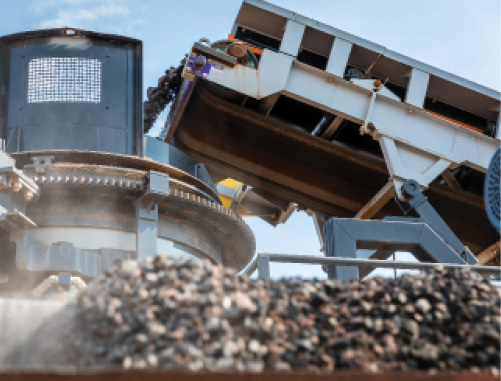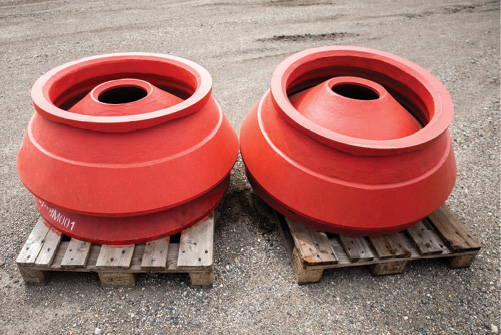
Are you using the optimum cone liners for your application? “It’s very important to choose the right liner for the feed size especially, and for the desired specifications and processing parameters,” said Curt Theisen, crushing technical support engineer for Superior Industries, whose rockface-to-loadout solutions team collaborates with producers to fine-tune processing circuits.
Whether specifying a new crushing circuit or tweaking an existing one, define your parameters upfront and share that data with your wear parts supplier.
- What is the actual day-to-day work that you’re asking that crusher to do?
- What is the required reduction ratio?
- What is the desired production throughput, tonnage and material type?
Knowing the precise composition, compressive strength, and chemical properties of the stone is a huge factor in determining how much work a cone crusher and its liners need to do.
Define Feed Size and Gradation
Most importantly, defining your top feed size and overall feed gradation is key to choosing the right liner configuration and the right feed opening. For example, you don’t want a 7-in. feed opening if the feed material is 3-in.-minus.
Top-size feed material that is too small for the opening causes premature wear to the bottom of the liners, while feed material that is too large or too coarse will speed wear to the top of the liners. Proper feed gradation allows for even wear patterns from top to bottom throughout the lifespan of the liner.
What is the formula behind a well-graded feed in crushing? Theisen stated that with a standard cone application, you would want 100% of the feed material to be equal to or smaller than 80% of the liner’s open-side feed opening. With a shorthead application, you would require 100% of the feed material to be equal to or smaller than the liner’s closed-side opening.

Examine all the Options
Work with a manufacturer who carries the full range of liner options, and one who has conducted wear studies on their liner types in a wide variety of applications. Make sure that your supplier offers cone liners that accommodate fine, medium, and coarse feed materials in both standard (secondary circuits) and shorthead (tertiary and quaternary) cone crushing circuits.
Additionally, work with a supplier whose liner portfolio offers varying percentages of manganese content – starting at 14% to 18% (standard in the industry), and up to 21%. Obviously, liners with less manganese are cheaper, but they won’t last as long either.
Certainly, the level of manganese content needed depends upon the material being crushed. If material is super abrasive, choose 18% to 21% manganese. However, if you’re processing softer materials such as dolomite or limestone, a liner with 14% manganese should suffice.
With complete application data in hand, Theisen stressed that it’s important for operations to work closely with their wear parts supplier to select the right liners. No matter what the application, there are chamber and liner configurations designed specifically to meet the desired product yield, while minimizing maintenance costs. Get the right data on your application and get the right liner fit for you.
Superior Industries, www.superior-ind.com
